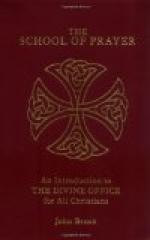“To the most holy and undivided Trinity, to the humanity of our Lord Jesus Christ crucified, to the fruitful virginity of the most glorious Mary ever a Virgin, and to the company of all the saints, be given by every creature, eternal praise, honour, power and glory, and to us the remission of all our sins. Amen. Blessed be the womb of the Virgin Mary, which bore the Son of the Eternal Father. And blessed be the breasts which gave suck to Christ our Lord.”
TEXT AND INTENTIONS TO AID THE PIOUS RECITATION OF COMPLINE.
1. “Into Thy hands, O Lord, I commend my spirit.”
2. “It is finished.”
3. “For this Thou hast redeemed us, O God of truth.”
General Intentions. The spread of the faith; the Pope; the Church in France and in Spain; for the Church in Australia.
Personal Intentions. A happy death; fervour in administering the last sacraments; devotion to St. Joseph, patron of a happy death.
Special Intentions, For the sick poor of Ireland; for persons dying without the last sacraments; for those dying all alone; for dying sinners.
THE LITTLE OFFICE OF THE BLESSED VIRGIN, (TITLE XXXVII.).
Origin. This Office dates from the eighth century at least. Pope Gregory II. (715-731) and Pope Gregory III. (731-741) ordered the monks to say this little Office in addition to their great Office. The practice was observed by St. John Damascene (676-787) and by St. Peter Damien (1007-1072).This usage was confined to monasteries only. At the end of the eleventh century the practice became almost universal. Pope Urban II. (1088-1099) besought the special aid of the Blessed Virgin in his crusade against the Turks and recommended all clerics to recite the little Office. Provincial councils prescribed its use and some canonists held it to be obligatory. However, the Bull Quod a nobis of Pope Pius V. (9 July, 1568) removed all obligation of the private recital of this Office, but he exhorted all to continue the practice and granted indulgences for its recitation.
PART IV.
NOTES ON SOME FEASTS.
CHAPTER I.
PROPER OF THE TIME.
ADVENT.
Advent (Latin, advenire, to come to) is a period beginning with the Sunday nearest to the Feast of St. Andrew (November 30) and embracing four Sundays. In the early Church there was a divergence of date and practice in Advent celebration. Thus, in France it began on St. Martin’s Day (11 November) and ended with Christmas, France kept Advent with tri-weekly fasts. Rome did not, in very early days, observe the Advent fasts, but maintained the shorter period, containing only four Sundays. (Father Thurston, The Month, No. 498).




